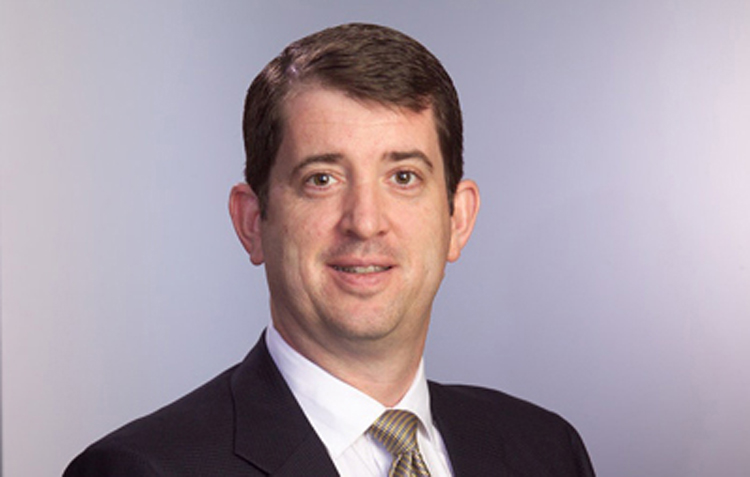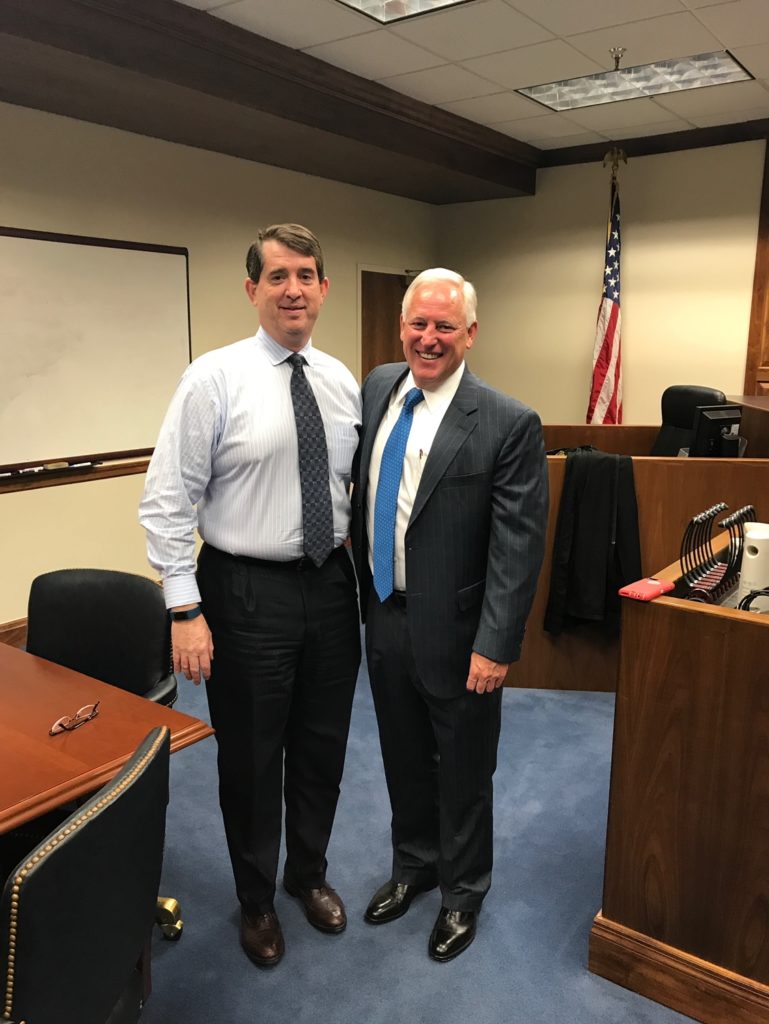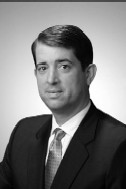
Southern District of Texas bankruptcy judges at a Bench Bar conference: (from left) Judge Richard Schmidt (retired); Judge David Jones, Judge Jeff Bohm, Judge Marvin Isgur
David Jones came home from work in 2011 and told his wife that he was quitting his million-dollar-a-year job at Porter Hedges to become a federal bankruptcy judge, which paid $160,000 annually.
“Don’t you think this is something we should have talked about first?” she asked.
“I told her that I could definitely see her point,” Jones said. “Not too much later, we were divorced.”
Fast forward nine years: Jones is now chief judge of the U.S. Bankruptcy Court in the Southern District of Texas and is widely heralded for making Houston the most popular jurisdiction in the U.S. for complex billion-dollar corporate restructurings.
Lawyers overwhelmingly agree that Judge Jones singlehandedly breathed new life into a Texas business bankruptcy practice that had witnessed nearly all its work shift to Delaware and Manhattan during the previous two decades.
Starting in 2016, Jones implemented a series of substantive reforms that created a special two-judge panel to handle the biggest and most complicated corporate restructurings, to provide parties increased access to court officials and to make procedures more transparent and predictable.
“Very few [large-dollar] complex bankruptcies were getting filed here,” Jones said in an exclusive interview with The Texas Lawbook. “There was not a next generation of Texas lawyers in the bankruptcy practice because there wasn’t a need. I was worried we would not have a generation of bankruptcy lawyers left in Texas.”
“I’m not married and have no children – just me and my three rescue dogs – and that has allowed me to put so much time and focus into making this work,” said Jones.

The result: Jones and fellow U.S. Bankruptcy Judge Marvin Isgur now have more business bankruptcies of $300 million or more – including filings by Neiman Marcus, J.C. Penney, Denbury Resources, Noble Corp. and Rosehill Resources – than any other bankruptcy court in the country.
New data provided exclusively to The Texas Lawbook shows that Judge Isgur had 303 high-dollar complex corporate restructurings on his docket as of July 31, including lead cases and subsidiaries. On Thursday, he added another case: London-based offshore drilling contractor Valaris filed to restructure citing up to $10 billion in liabilities.
Judge Jones has 770 such business bankruptcies on his docket.
Isgur has 10 Chapter 15 corporate insolvency cases. Jones has 15. In addition, both judges are currently handling more than 3,000 consumer bankruptcies.
“David shows that the force of one determined person to get something done,” Isgur told The Texas Lawbook. “He decided everything we did would be more consumer friendly. The fact is, he just did it. He did it, and then he persuaded me to do it.”
In a series of lengthy interviews conducted over the past three weeks, Jones opened up about his love of the Duke Blue Devils, helping famed criminal defense attorney Richard “Racehorse” Haynes and others build a database for a high-profile trial in 1988, the time he was “arrested” by the U.S. Coast Guard for stealing a 65-foot boat from the Bahamas, his deep concerns about one of the biggest oil and gas bankruptcy cases currently on his docket and his dream of becoming a welder.
Judge Jones – ‘The Force’
There is no doubt that Judge Jones will go down in history for reinvigorating the corporate restructuring practice in Texas, resulting in hundreds of millions of dollars in annual revenue for lawyers, bankers and financial consultants in Houston.
There were 602 companies that filed for bankruptcy in the Southern District of Texas during the first six months of 2020 – more than triple the number from the prior six months, according to data provided exclusively to The Texas Lawbook by Androvett Legal Media Research.
Legal experts predict that hundreds of more businesses will seek Chapter 11 protection over the next four months in Texas.
“The goal was never to be busier than anyone else,” Jones said. “The goal was to have a bankruptcy court where I always wanted to practice and where it wasn’t about the judge but all about the case.”
In fact, the objective of Jones’ reforms was to persuade large Texas companies to consider restructuring through courts in Houston instead of filing for bankruptcy in Delaware and the Southern District of New York, as Enron, American Airlines, Energy Future Holdings, Radio Shack, Dynegy and dozens of other large Texas businesses had done for the past 20 years.
Those reforms have proven so successful that even several large corporations headquartered outside of Texas have filed their bankruptcies in Houston, including Chesapeake Energy of Oklahoma City, California-based Men’s Warehouse, Los Angeles-based California Pizza Kitchen and Kansas-headquartered NPC International, which is the largest Pizza Hut and Wendy’s franchisee in the U.S.
“Judge Jones has been the force behind this,” said John Higgins, a partner at Porter Hedges who practiced with Jones for several years. “He got the bankruptcy bar and the federal district bench together and made it happen.
“Having a consistency on rulings and constant access to the courts was a huge problem before,” Higgins said. “When you seek an emergency hearing on a billion-dollar filing and restructuring, it would sometimes take a couple weeks.
“Judge Jones and Judge Isgur rule quickly and decisively,” he said. “The war on legal fees the lawyers had with some judges is also over.”
Top corporate bankruptcy lawyers now charge between $1,200 and $1,700 an hour.
“My hourly rate when I left Porter Hedges was $550,” Judge Jones said. “Even that seemed so high to me at the time. The rates today – wow. But I’m a big believer in the market, and I don’t think judges should regulate the market.”
Alfredo Perez, a bankruptcy partner at Weil, Gotshal & Manges in Houston, said judges Jones and Isgur “have a business background and they understand how business operates.”
“Judge Jones has given his heart and soul to enhancing the reputation of the bankruptcy court in Houston,” Perez said. “Both judges are tech savvy and always accessible. They have done a really good job of welcoming the counsel who practice before them.”
Dream of Filling the Low Post at Duke
Judge Jones, who is 58, was born and raised in rural North Carolina. His mother was an elementary school teacher for 43 years. He had no relationship with his father. His grandfather upholstered furniture. There were no lawyers in the family.
After receiving his degree in engineering from Duke University in 1983, he worked for a large defense contractor doing chip design for missile guidance systems. A year later, he moved to Dallas to get an MBA from Southern Methodist University. He graduated in 1986 and went to work for an accounting firm.
In 1987, Jones’ life took a turn. He was hired to design a document management system for defense lawyers representing about 120 developers, appraisers and bankers in the I-30 savings and loan/fraudulent condominium scheme. One of the lawyers he worked with was Richard “Racehorse” Haynes of Houston.
“Being around such great lawyers was a fun experience and was the push I needed to go to law school,” he said.

Eighteen months later, Jones started law school at the University of Houston Law Center.
During his second year, a couple of lawyers asked him to be a consultant overseeing their development of a computer networking system. They met for lunch at the Black-eyed Pea restaurant near the U of H campus.
“I was always trying to keep our firm [Kirkendall & Isgur] on the technological forefront, and we needed a consultant to help us network all of our computers,” said Houston bankruptcy lawyer Tom Kirkendall.
Kirkendall said that he and his then-law partner Marvin Isgur hired Jones on the spot to oversee the tech professionals that they had hired to do the job.
“Within a couple weeks, David had run off all the tech people we had hired,” Kirkendall said. “David did the work himself and we had the best computer network of any law firm in Texas, and he did it at a fraction of the costs.”
Isgur and Kirkendall were obviously impressed, as they hired Jones to join the law firm as an associate when he received his law degree in 1992.
“We knew he was going to be a great lawyer,” Kirkendall said. “Plus, David showed great deductive reasoning early in his life when he realized that there was not much of a future for him as a 6’2” walk-on power forward at Duke.”
Coast Guard to Jones: ‘Don’t Throw Anything Overboard’
Jones’ first big case came during his second year at Kirkendall & Isgur, a Houston boutique that specialized in complex corporate bankruptcy litigation.
The firm was hired by the court-appointed trustee in the restructuring of Guyana Development Corp., an oil and gas-focused holding company that owned and managed assets in multiple countries.
GDC filed for bankruptcy protection in Houston in 1993 citing $8 million in assets, but undetermined liabilities were the subject of dispute with the IRS.
“It started off as a small asset bankruptcy involving a tax dispute over the sale of a Massachusetts office complex, but it blossomed into a $100 million case,” Jones said. “There was one point when I was in Zurich, Marvin was in the Isle of Man and someone else was in London.

“We were tracking down money flying all around the world,” he said. “We learned how to operate simultaneously in several countries at once.”
Court records show that the GDC bankruptcy trial unearthed the “existence of fraud in the operation of the estate” involving company insiders, including GDC principal Edward Callan.
Over a period of two years, Isgur, Kirkendall and Jones pursued litigation in five different countries and seized property in multiple states and a handful of foreign nations.
“The trustee discovered that debtor’s books and records were in total disarray,” U.S. Bankruptcy Judge Karen Kennedy Brown wrote in awarding $2.4 million in fees to the law firm. “Some records were maintained on a computer so old that access was difficult, some were contained in locked file cabinets.”
“The disorganization of debtor’s records was compounded by debtor’s insiders’ deliberate attempts to misappropriate records,” Judge Brown wrote. “Insiders moved records all over the world.”
Jones and the others found some records in the back of a car in London and others on a truck in Houston.
But the highlight of the case for Jones came in 1994 when he learned that Callan had purchased a 65-foot yacht called the M/V Scorpion for $385,000 with estate funds.
“We got a tip that the boat was at the [Hurricane Hole] Marina in Nassau, and we got a court order that we got to take the boat,” Jones said. “I flew to Miami and hired a boat captain. I had $25,000 in cash in case I had to pay an ‘exit fee’ to take the boat out of the harbor.
“We arrived in the dead of night – no one there except the harbor captain,” Jones said.
Everything was going smoothly, according to Jones, when the boat suddenly stalled about halfway between Nassau and Fort Lauderdale.
“Apparently there was algae growing in the fuel lines and clogged the engine, and the boat died near Bimini,” he said.
After having the boat towed to a marina and repaired, Jones and the captain set out through the Straits of Florida toward Fort Lauderdale when they were hit with another surprise.
“This Coast Guard helicopter was hovering over us, yelling sat us to turn off the engine and told us, ‘Don’t throw anything overboard,’” Jones said. “I was standing in the back of the boat waving this court order in the air.”
The Coast Guard finally reviewed the court order, and Jones and the boat captain were on their way. They ended up selling the M/V Scorpion for $300,000.
“David was a good lawyer because he was not afraid of taking on difficult cases,” Kirkendall said. “He understood he had to be creative.”
Jones – the Lawyer
Jones said he chose to work with Kirkendall & Isgur over other law firms that recruited him for one simple reason: “I told them that I want to go to court every day and I want to be a self-supportive, talented bankruptcy lawyer,” he said. “They told me that if I went to work for them, I would go to court tomorrow.”
Isgur and Kirkendall agree that Jones’ skills as a lawyer were self-evident.
“Right after he passed the bar, we went to a hearing together, and it was clear right away that he was going to be a star,” Judge Isgur said. “He was a very aggressive lawyer.”
In 2004, Isgur left the firm to become a federal bankruptcy judge in Houston.
“Marvin trained me. We’ve been friends for 30 years. We have great communications,” Jones said. “He taught me patience. He taught me to always try to leave a little something for the other side. This is who Marvin is – he is the essence of a judge.”
“I love him like a father,” he said.
A year later, Jones moved his legal practice to Porter Hedges.
“David would come to the office on Saturdays wearing a Duke T-shirt and shorts and would have documents all over the floor looking for potential new clients,” said Higgins, who officed next to Jones for nearly seven years.
“David frequently took no depositions in cases, and he just showed up for trial like an old-fashioned criminal defense attorney,” he said. “The joke around the firm was that David never ran conflicts checks.”
“Simply put, David Jones is one of the best bankruptcy lawyers I have ever met,” Higgins said.
‘No Designs to be a Judge’
In 2011, Judge Jerry Smith of the U.S. Court of Appeals for the Fifth Circuit approached Jones, told him that he had made enough money in his career and said he should accept an appointment to the bankruptcy court in the Southern District of Texas. It was an opportunity to join his mentor, Isgur, who was then the chief judge, on the bench.
“I had no designs to be a judge,” Jones said. “I loved being a lawyer. It was one of the true privileges of my life.”
To be truthful, much of the Texas bankruptcy bar had doubts about Jones as a judge, too.
“There were a lot of concerns about my temperament early on,” he said. “I was a litigator with a litigator’s mentality. It didn’t bother me as a lawyer to turn up the tension in a case.”
The lawyers who know him best admit there were widespread concerns.
“David, in his practice, was never one to take any prisoners,” Higgins said. “He was an aggressive lawyer, and there was fear that he would inject himself into cases and even start calling his own witnesses.”
On the bench, Judge Jones has put those fears to rest.
“David realizes that nobody knows everything about business,” Kirkendall said. “David has no problem telling the lawyers, ‘Whoa, slow down and explain this to me again.’ He is an outstanding judge.”
Jones said that Judge Isgur has been as much of a mentor on the bench as he was practicing law. But he said they do have differences.
“Isgur is black and white and writes a lot,” Jones said. “I’m very gray and I don’t like to write.”
To be sure, Jones has his pet peeves that attorneys should avoid.
“The biggest is that he does not like it when people interrupt him or start talking while he is still talking,” Higgins said. “And he is still pissed that the Boy Scouts did not file for bankruptcy here.”
The Dallas-based Boy Scouts filed for Chapter 11 protection in Delaware earlier this year.
The other Southern District of Texas judges elected Jones to be their chief in 2015. That’s when he started focusing on creating the complex business docket for Chapter 11 restructurings.
“A key was convincing my colleagues that consistency was a critical factor,” he said. “There were some tough discussions. There could only be two judges doing this to make it work.”
Judge Jones said it took two years to get the special docket structured correctly. Because filings are done electronically, the court created a special designation for lawyers to mark the case as complex – 111 instead of just 11. The 111 marked cases automatically go to Isgur and Jones.
“Predictability and access are so important for the bar because the numbers are so big in some of these cases,” he said.
Judge Jones obtained a government cellphone for his case manager, who answers it 24-hours a day.
“He is the public’s way to talk with me.,” he said. “He has tremendous scheduling authority. He’s great at customer service.”
“The engineering mentality is engrained in everything I do,” Jones said. “We engineers fix things. And that is what we are trying to do in bankruptcy cases. It has been a constantly evolving process,” he said.
Judges Jones and Isgur agree that, despite the wave of large corporate restructures filed with them so far this year, they are not overwhelmed – in fact, they have yet to reach capacity. And they make it clear that they do not need additional help at this point.
“There will never be more than two judges on the complex panel,” Jones said. “It doesn’t work if there are more than two.”
The Linn Energy bankruptcy case has been Judge Jones’ favorite to handle so far.
Linn filed for Chapter 11 protection in 2016, citing $8.28 billion in liabilities and assets of $11.6 billion. As part of the restructuring, Linn reduced its debt by $5 billion, had an infusion of new capital and divided the operation into two separate entities.
“I had some really good lawyers involved in the Linn Energy case,” Jones said. “They did a great job listening and then they went and did something good for the world. It was a great example of great legal talent focused in the right direction.”
A current case that Jones has serious concerns about is Chesapeake Energy. Two weeks ago, lawyers and bankers working on the restructuring of the Oklahoma-based oil and gas E&P company were before Jones seeking approval of debtor-in-possession financing.
“The case bothers me because it was really hard to understand the benefits being given,” he said. “Because of the risk involved, it is very expensive. It is not quite lending into a black hole, but it seems to be lending into a dark gray hole.”
“In a normal world, I would never have approved this,” he said. “But this is not a normal world.”
Jones doesn’t deny that many business bankruptcies can be dramatic and personal.
“The loss of jobs in these cases really affects me emotionally,” he said. “Letters from shareholders who have seen their life’s investment wiped away are very difficult to read, but I read them all. It is heartbreaking.”
Jones’ term as chief judge ends next May and his 14-year appointment concludes in 2025, when he will be 64.
“I would be lying if I said I didn’t have any regrets,” he said. “I miss being a player in the game. I miss developing and implementing case strategy. But I get to do the right thing. I would never go back to the practice of law.”
If Jones isn’t reappointed to the bankruptcy bench in 2025, he has a backup plan in mind.
“I have grand designs on being a welder,” he said. “I’m taking welding lessons. The No. 1 lesson is always wear welding gloves no matter the size of the project.”
